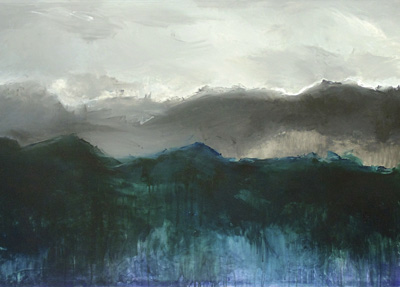[vc_row][vc_column][vc_column_text]
Painting as a Whim
By Dayneris Brito
«The aesthetic experience of man nourishes from no other essence but the conscious inquiry about his eternal problems».
Rufo Caballero
There is something in María Karla Watson’s earliest painting (Havana, 1991) that takes me to the nihilistic photography of French artist Sophie Calle, respecting the obvious notions of different formats, contexts and temporalities. Calle directs her aesthetics to the narration of personal stories that comprise from the tragic events given by the inexperience of her youth to the dissimilar amorous failures during the course of her life. To do so, she ignores the human reference in the analogical image and moves rather towards the registration of dissimilar objects present at the moment of the rupture (a telephone, a pillow, a plane ticket), on which lie the suffering and unhappiness self-referenced by the artist.
In the series Back to School (2006-2015), María Karla Watson explores the limits of drawing and collage to give us a painting that ponders figurative language to the detriment of a naturalistic form more attached to reality. Her immature concerns and frustrations are the pretext for unveiling grotesque and mannerist planes, moving incipiently towards graffiti and art brut. But just as in the work of her French counterpart, she dispenses with the figurative model and embraces the most diverse pictorial motifs, allegorical to ballasts and incomprehension from her adolescence.
Everything that is represented here contributes to create small subplots of this stage of his life: flowers, old photos, fragments of torn letters, as misplaced pages of a diary. Thus, she randomly mixes the colors, squeezes the paper, superimposes the formats, adds varied typographies and recreates through variegated collages iconoclastic compositions that lack all craft and technical notion. That is why her aesthetics struggles within the spaces of the most evident childish painting, at times with tints of kitsch.
The self-reference as zone of self-expression in which the artist finds herself as subject of expression in the work becomes another motif induced in Back to School. The pieces contained here are crossed obliquely by humanoid features (heads, hands, backs) and phrases of dissimilar nature that refer to intimate subjectivities in María Karla. But beyond appropriating living experiences and suggesting them in frivolous and trivial tone, form and concept dialogue in the work with the very notion of art and intuit another way of assuming it, creating doubts about the value of the new or original. Hence her transgression of the organic structure of the piece and the advocation of opinions such as: «For me, a dossier is something kitsch and ugly but what choice have I got?…, or I discovered these tiny dots which I liked». That is why the expressionist gesture appears in Procesos in the artistic nonconformity, the constant experimentation and the tearing of traditional methods, to the point of reaching sketches in this first stage that do not appeal to the mimetic formula, but to its schizoid sign.
From her collages she arrives at a new neo-figurative aesthetics that produces a thematic-conceptual leap in the evolution of her painting. She gradually ventures into the landscapist representation but again submits the direct reference to the primacy of the impressionistic and subjective gaze. They are warm scenes that apparently seem out of context, out of reach for any space-time anchorage. However, the self-referential accent reappears once more in her work, no longer from the questioning position, concerning personal vestiges of the author, but from the romantic representation of views that denote in small portions her emotional and spiritual states.
After experiencing with the traditional genre for a certain period, she returns to the trade in her latest series entitled Niebla (Fog) (2017-2018), where there is an oblique turn of her previous aesthetics breaking completely with the themes and supports so far privileged by the artist. In place of the undone gesture, the exasperation and the formal flirtation, she heads towards the calmness and the stillness of cold and illusorily inexpressive landscapes, supported by white tones and the recreation of material volumes. As they simulate impassive scenes devoid of meaning and vehemence, an evident game is reactivated between the viewer and the work, between what we see and what we feel. In this case, loneliness, lack of communication and human isolation stand out as the sources of discourse from which to benefit.
Although with clear technical and conceptual gaps, the work of María Karla Watson oscillates between one comfort zone and another. Her aesthetics, autobiographical par excellence, determines the persistence of a genre, a sex, with its own vicissitudes and melodramas. And the two-dimensional method is enough for that: the imprint left through the immortality of the canvas and the constant play with it (its attachment and then its coating).
[/vc_column_text][/vc_column][/vc_row][vc_row][vc_column][vc_gallery interval=»0″ images=»7427,7428,7429″ img_size=»1200×692″ css=».vc_custom_1549928685672{margin-top: 10px !important;}»][/vc_column][/vc_row]



